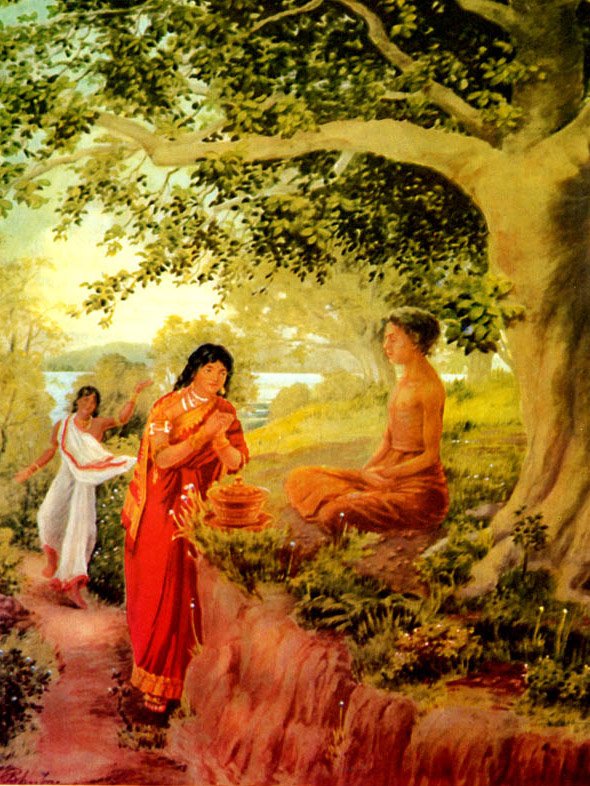Apadana commentary (Atthakatha)
by U Lu Pe Win | 216,848 words
This is the English translation of the commentary on the Apadana (Atthakatha), also known as the Visuddhajana-Vilasini. The Buddhist stories known as apadanas refer to biographies of Buddhas, Buddhist monks and nuns. They are found in the Pali Canon (Khuddaka Nikaya), which is the primary canon of Theravada Buddhism. Alternative titles: Visuddhaja...
Commentary on Biography of the thera Avopupphiya
Stanzas starting with Vihārā abhinikkhamma constitute the biography of the venerable thera Avopupphiya. This one also having done devoted service toward former Buddhas, accumulating meritorious deeds conducive towards escape from rounds of rebirth 9vaṭṭa), in this or that existence, was reborn in a family house at the time of the Glorious One Sikhī; on having attained the age of intelligence he became endowed with pious faith, listened to the truth (dhamma), got delighted, took in both hands different kinds of flowers, and distinctively strewed them over Buddha. On account of that act, he wandered about his rounds of rebirth among divine and human-beings, enjoyed heavenly bliss and the prosperity of a world-king, was everywhere revered, and was reborn in a family house when this Buddha arose; on his having grown up to age he came to have pious faith in the dispensation, renounced the world and became an arahat not long afterwards even. Ā, from all round, it opens and illumines; thus, ākāso (sky); he was well-known as Avopupphiya thera because of scattering down of flowers in that sky.
7. Having thus attained the tranquil path, he recollected his own former deed became pleasure-minded and uttered a stanza starting with vihārā abhinikkhamitvā in order to make manifest the deed done by him formerly. There, vihārā (from monastery) distinctively carries, brings (or makes) to turn out one's body not to be falling, by means of four kinds of postures (iriyāpatha); thus, vihāra, (monastery); from that monastery; abhi, distinctly, nikkhamma, having come out;abbhuṭṭhāsi ca caṅkamati (rose up as well as walked to and fro) for the purpose of walking to and fro, he rose up distinctly on the cloister of sixty cubits, he ascended; thus, is the meaning. Catusaccam pakāsento (in order to make clear the four noble truths) walking to and fro on that cloister, demonstrating, making manifest the four noble truths reckoned as pain (dukkha), origin of pain, (samudaya) cessation of pain (nirodha) and the noble path, showing, analysing clearly, making nibbāna (the immortal path) manifest, walks to and fro there; thus, is the connection.
8. Sikhissa giramaññāya, Buddhaseṭṭhassa tādino (having come to know the speech of the such most excellent as Buddha Sikhī) having known and understood the speaking sound and vocal voice of Buddha Sikkhī, endowed with such most excellent qualities; nānā puppham gahetvāna (having taken different kinds of flower) having taken and brought many a such flower as: nāga, pannāga, and so on; ākāsamhi samokirim (I scattered down properly in the sky) I scattered down and reverentially offered in the sky over the head of the promenading Glorious One.
9. Tena kammena dvipadinda (O Sovereign of bipeds! on account of that act) O ruler and main chief of such two-legged creatures as divinities, Brahmā and human beings! narāsabha (O big-bullman!) O you, who had become the big bull among men! Pattomhi acalam ṭhānam (I attained the unshaken place) having become a monk in your presence, I am and I have become one who had;attained nibbāna, the unshakable place; hitvā jayaparājayam (having forsaken victory and defeat) having abandoned victory also reckoned as divine and human bliss, and having discarded defeat reckoned as four painful forms of purgatory, I am one who has attained nibbāna; thus, is the meaning. The rest is but easily comprehensible.
The commentary on the biography of the thera Avopupphiya has ended.
